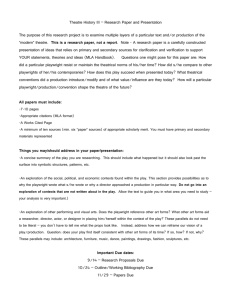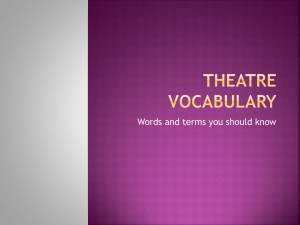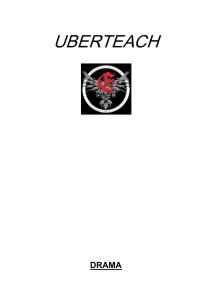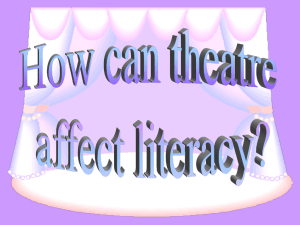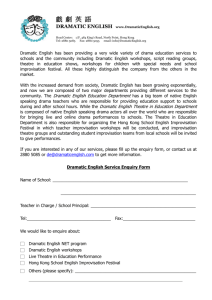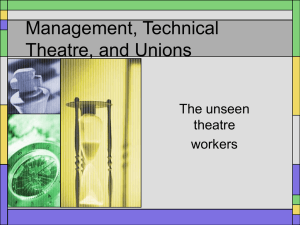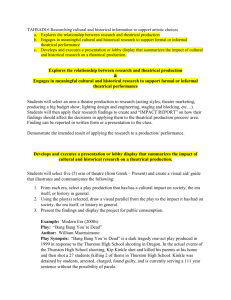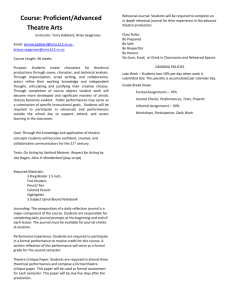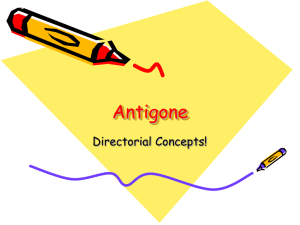Theatre glossary
advertisement
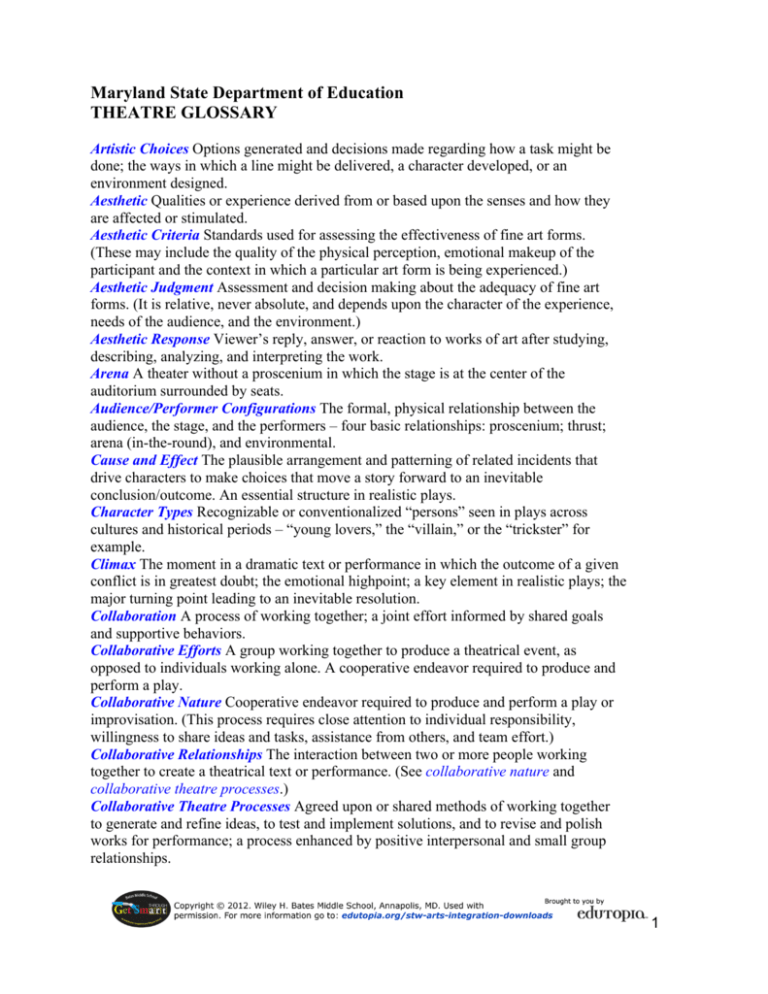
Maryland State Department of Education THEATRE GLOSSARY Artistic Choices Options generated and decisions made regarding how a task might be done; the ways in which a line might be delivered, a character developed, or an environment designed. Aesthetic Qualities or experience derived from or based upon the senses and how they are affected or stimulated. Aesthetic Criteria Standards used for assessing the effectiveness of fine art forms. (These may include the quality of the physical perception, emotional makeup of the participant and the context in which a particular art form is being experienced.) Aesthetic Judgment Assessment and decision making about the adequacy of fine art forms. (It is relative, never absolute, and depends upon the character of the experience, needs of the audience, and the environment.) Aesthetic Response Viewer’s reply, answer, or reaction to works of art after studying, describing, analyzing, and interpreting the work. Arena A theater without a proscenium in which the stage is at the center of the auditorium surrounded by seats. Audience/Performer Configurations The formal, physical relationship between the audience, the stage, and the performers – four basic relationships: proscenium; thrust; arena (in-the-round), and environmental. Cause and Effect The plausible arrangement and patterning of related incidents that drive characters to make choices that move a story forward to an inevitable conclusion/outcome. An essential structure in realistic plays. Character Types Recognizable or conventionalized “persons” seen in plays across cultures and historical periods – “young lovers,” the “villain,” or the “trickster” for example. Climax The moment in a dramatic text or performance in which the outcome of a given conflict is in greatest doubt; the emotional highpoint; a key element in realistic plays; the major turning point leading to an inevitable resolution. Collaboration A process of working together; a joint effort informed by shared goals and supportive behaviors. Collaborative Efforts A group working together to produce a theatrical event, as opposed to individuals working alone. A cooperative endeavor required to produce and perform a play. Collaborative Nature Cooperative endeavor required to produce and perform a play or improvisation. (This process requires close attention to individual responsibility, willingness to share ideas and tasks, assistance from others, and team effort.) Collaborative Relationships The interaction between two or more people working together to create a theatrical text or performance. (See collaborative nature and collaborative theatre processes.) Collaborative Theatre Processes Agreed upon or shared methods of working together to generate and refine ideas, to test and implement solutions, and to revise and polish works for performance; a process enhanced by positive interpersonal and small group relationships. 1 Comedy A humorous form concerned with love or human failings, usually contains a positive ending highlighting reconciliation, a world rebalanced or the regeneration of love and good will. Conflict Forces or characters with competing and opposing needs or wants; an essential element in causal plot structure. Conventions (TV, Film) Commonly accepted devices, principle, procedures, and forms that structure the presentation of content and facilitate storytelling (close-up, jump cut, for example). Conventions of Architecture Commonly accepted devices, principles, procedures, and forms that influence the design and construction of a building or structure; identifiable structural and aesthetic elements that define the form and style of a building. Conventions of Performance Commonly accepted devices, principles, procedures, forms, and expectations that define the presentation of a play, improvisation, or written dramatic text. (These may be associated with an historical period, culture, or playwright.) Culture The shared ideas, beliefs, customs, and experiences of a given people at a given time and place. Dramatic Action The rendering of character intention, motive, volition; the element that creates forward movement in a dramatic text; what a character is trying to do or accomplish in a play or scene. (The action might be physical or psychological.) Dramatic Form Categories of drama which represent differing views of and responses to human experience: tragedy, comedy, melodrama, farce, and mixed forms. Dramatic Literature The written text of a play as constructed by a playwright or team of writers. Dramatic Structures Various means used to organize a dramatic text or production; elements of plot, character, language, thought, music, and spectacle, arranged in differing configurations. (Four conventional plot structures might include climatic, episodic, situational, and reflexive. Structures may be identified with specific historical periods, cultures, or playwrights.) Dramatic Texts The written text of a play as constructed by a playwright or team of writers. Dramatic Works Refers to written dramatic texts and scenarios as well as improvised and non-language-based performances. Dramaturg A specialist who works with a theatre company to select a season; researches cultural/historical/contextual information to aid directors and playwrights, and support the development of production concepts and program notes. Environments Synonymous with setting or sets. However, it may also refer to the total effect of all the visual and aural elements of a performance. (See world of the play.) Exposition Information in a dramatic text that provides audiences with character and story background needed to understand the current/given situation. (It may appear early or late in a text or be offered throughout the text.) Farce An extreme form of comedy, often physical, containing challenges to authority/the status quo, extreme situations, and highly coincidental plots. 2 Formal Elements of Performance Character, environment, language, action, and the use of time and space to communicate ideas, intentions, and meaning. The given circumstances of a play or scene – who is involved, what is happening, where the action occurring, when the action occurring (chronological time and historical period), how the characters and actions are revealed, and why do characters make certain choices, take action. Form Comedy, tragedy, melodrama, farce, and mixed forms. (See dramatic forms, genre.) Genre Categories of drama which represent differing views and responses to human experience: tragedy, comedy, melodrama, farce, and mixed forms. Improvisation The spontaneous or loosely planned use of speech and /or movement to create characters, settings, and dramatic action. Improvisational Play The spontaneous inventions of actors used to explore character, plot, and/or language; a free flowing investigation of theatrical ideas and actions. Locomotor Movement Movement through space involving a change in location; a moving base involving a progressive relocation of the body in space. (Examples of basic steps are walk, run, leap, hop, and jump. Skip, slide, and gallop are examples of irregular rhythmic combinations.) Melodrama Generally refers to plays that present a schematic conflict between good and evil, with good prevailing. Mixed Forms Dramatic texts and productions that mix dramatic forms producing hybrid effects – for example, a tragic comedy or seriocomic work Narrative/Non-narrative Dramatic works containing a linear and often causal progression of events and motives (narrative); dramatic works that subvert causal structures or use other organizational principles and approaches (non-narrative). Narrative Structure/Narrative Conventions Includes (but is not limited to) exposition, inciting incident, rising action(s), crisis, climax, resolution/denouement—structural elements that introduce, develop and resolve character conflict(s) in storytelling; the predominate structure seen in realistic film, television and theatre. Non-Locomotor Movement Movement that occurs above a stationary base; movement of the body around its own axis. (Also called axial movement, it includes bending, stretching, pushing, pulling, bouncing, swinging, shaking, and twisting.) Other Literature of the Theatre Includes manuals or literature regarding dramatic theory, theatre history, or practice in addition to dramatic texts. Performance Values The manipulation of time, space, movement, the voice and the body to communicate character, action, and environments. Playwright The author of a theatrical script intended for performance. (It may reflect the efforts of a single individual or collaborative group.) Practices Techniques, traditions, and methodologies of the theatre applied to writing and performance. Principles Organizing concepts for creating and understanding theatrical works. Presentational A style of performance that celebrates the artifice of theatre with little or no attempt to disguise lighting or technical effects. 3 Protagonist The principal character in a dramatic text. The leading character whose story, actions, and outcome (triumph of defeat) is of primary concern. Readers’ Theatre A style of theatre featuring minimal movement and scenery and relying instead on the vocal expressiveness of the actor, and the spoken word to create a sense of place, character, and action. Realism A style of theatre in which characters, dialogue, events, design elements, and performance techniques conform to or reproduce observable reality, appear as everyday life. Representational A style of performance that attempts to hide or reduce the artificial nature of theatre to create a realistic effect. Resolution Follows the climax in causal plot construction: emotional intensity drops, loose ends are tied up, and order is restored. Skits Short works for performance that may be text or non-text based, improvised, or scripted. Staging Conventions/ Theatrical Conventions Elements of theatrical performance and production accepted by a given community that facilitates theatrical presentations; traditions and expectations held by theatre practitioners and audiences of a given historical period. Storytelling Conventions Elements common to storytelling across cultures and historical periods, such as establishing the who, what, when, where, why, and how, and creating a story structure containing a beginning, middle, and end. Styles Codified characteristics and expressive choices that influence the form and content of a dramatic text or production. (It may be associated with a given playwright, historical period, culture, artistic movement, or design approach, including realism, naturalism, romanticism, theatricalism, expressionism, the absurd, and the postmodernism. Techniques Methodologies that facilitate fluency in the execution of a given task. Theatrical Conventions/Staging Conventions Elements of theatrical performance and production accepted by a given community that facilitates theatrical presentations. Traditions and expectations held by theatre practitioners and audiences of a given historical period. Theatrical Elements The individual components of theatre: space, movement, language (speech and text), light, sound, properties, and scenery. Theatrical Structures Forms, styles, and controlling elements that shape dramatic texts or influence an audience’s perception of a given performance. Themes Theatrical works that share a commonality based in human experiences and that show the relationships of individuals to each other and within social groups. (Examples include the same subject matter, style, technique, or concepts.) Thrust A theater stage that extends out into the audience’s part of a theater and has seats on three sides Tragedy A dramatic or literary work depicting a protagonist engaged in a morally significant struggle ending in ruin or utter disappointment Universal Themes Theatrical works from a variety of cultures that share a commonality based in human experiences and that show the relationships of individuals to each other and within social groups. (Examples include the same subject matter, style, technique, or concepts.) 4 World of the Play The physical and psychological reality as suggested by a theatrical script and/or production; the cumulative effect of textual and production elements that render or suggest the unique reality of a given play 5
